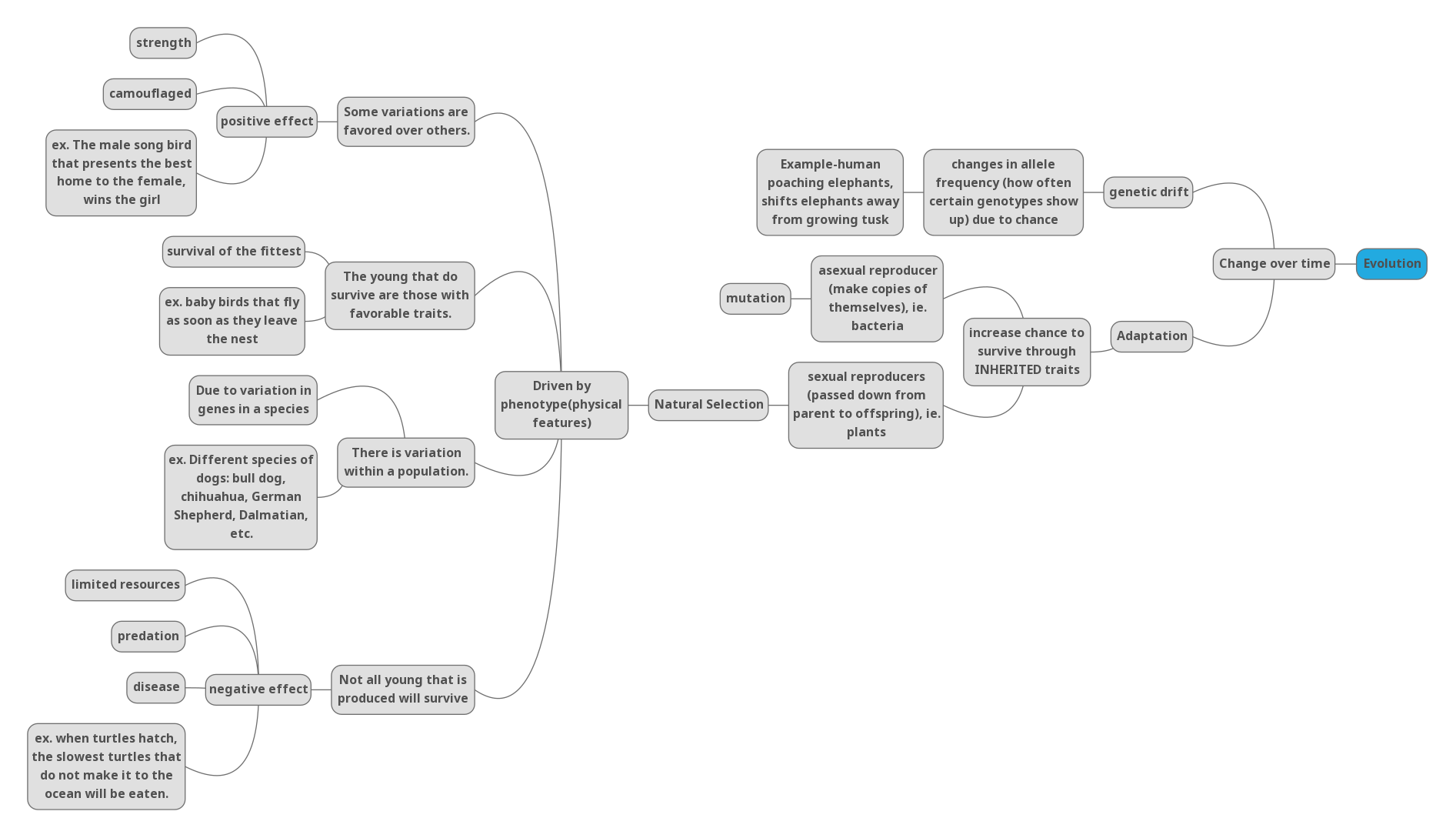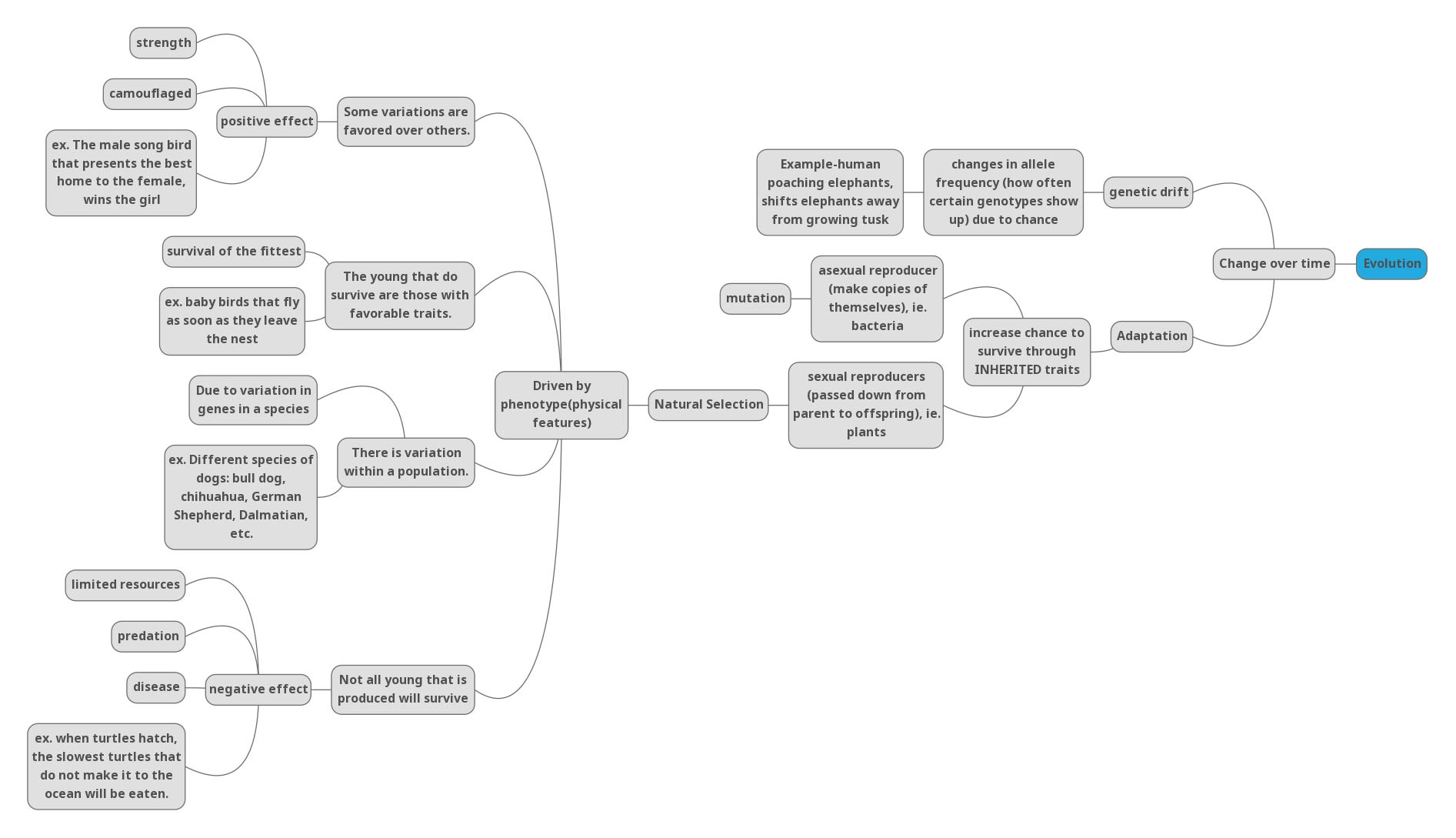Summary
In this lesson, students will learn about the four points of natural selection and how they drive the evolutionary patterns of a species. Students will determine how to answer evolutionary questions through interpreting graphs and making connections among natural selection concepts. Students also will discover how advantageous traits can increase the survival rate of a species, while unfavorable traits can lead to extinction. This is a multimodality lesson, which means it includes face-to-face, online, and hybrid versions of the lesson. The attachments also include a downloadable Common Cartridge file, which can be imported into a Learning Management System (LMS) such as Canvas or eKadence. The cartridge includes interactive student activities and teacher's notes.
Essential Question(s)
How does natural selection contribute to the expansion of some species and the decline of others?
Snapshot
Engage
Students watch a video of a competition between two moose and make predictions about what its outcome means for the moose involved. Students also predict whether one species can influence the evolution of another species.
Explore
Students complete a natural selection lab, collect data, and interpret results. Students add the main ideas to a brainstorming document as they prepare to create a Mind Map.
Explain
Students read an article and watch a video to learn more about the four points of Darwin’s natural selection. Students add the main ideas to their brainstorming document and then use the document to develop a Mind Map.
Extend
In groups, students create a comic strip about the four points of natural selection and share it with their peers.*
Evaluate
Students reflect on the lesson and write a summary on the effects of natural selection.
*The online version does not include the comic strip assignment. Instead, the instructions for developing a virtual Mind Map can be found in the Extend section rather than the Explain section.
Instructional Formats
The term "Multimodality" refers to the ability of a lesson to be offered in more than one modality (i.e. face-to-face, online, blended). This lesson has been designed to be offered in multiple formats, while still meeting the same standards and learning objectives. Though fundamentally the same lesson, you will notice that the different modalities may require the lesson to be approached differently. Select the modality that you are interested in to be taken to the section of the course designed for that form of instruction.
Materials
Lesson Slides (attached)
Mind Map Instructions and Brainstorming Document (attached; one per student)
R.E.R.U.N. Rubric (attached; optional; one per student)
Cognitive Comic Strip Instructions (attached; one per student)
Cognitive Comic Strip Template (attached; optional; one per group)
Comic Strip Examples (attached)
How I Know It handout (attached; one per student)
Toothpicks, plastic forks, spoons, and knives (one of each per group)
Large paper plates (two per group)
Bag of beans (one handful per group)
Raisins/marshmallows (one handful per group)
One paper cup (one per student)
Stopwatch or timer (for timekeeper)
Sticky easel pad paper or butcher paper (one per group)
Markers (Mr. Sketch, Sharpie, etc.)
Colored pencils
Pencils/pens
Large screen with a classroom setup that allows videos and slides to be displayed for everyone to view
Engage
15 Minute(s)
Introduce the lesson using the attached Lesson Slides. Display slide 3 to read aloud the essential question: How does natural selection contribute to the expansion of some species and the decline of others? Display slide 4 to go over the lesson objectives. Review these slides with students to the extent you feel necessary.
Go to slide 5. Have students watch the following video: "Watch Moose Fight in a Quiet Alaska Suburb." After the video, move to slide 6 and pose the following discussion questions for students to write down and then answer verbally or via Mentimeter (see notes below):
What do you think caused the two moose to battle?
What do you think will be the outcome for the moose that lost the fight?
Next, go to slide 7. Place students in groups of four. Then, have students get out a piece of paper and answer the following prompt:
Do you believe an organism from one species can cause a different species’ genes to mutate into a different physical feature?
When students are finished writing, display slide 8. Using the Chain Notes strategy, have students pass their papers clockwise. Each paper’s recipient should choose one of the points their peer made and add an additional fact, idea, or correction to it through words or a drawing. Repeat this process of passing clockwise and writing until the papers get back to their original writers.
After the original writers review the comments their peers made on their paper, have each group come up with a summary of their ideas to share with the class. Select one student from each group to share their summary.
After the discussion, move to slide 9 and have students watch the video titled "The Evolution of Dogs." After the video, ask students if their original opinion has changed and why or why not.
Explore
30 Minute(s)
Display slide 10. Explain to students that, later in the lesson, they must create a Mind Map about natural selection. In this section, they must complete several activities to prepare for the creation of their maps.
Pass out a copy of the attached Mind Map Instructions and Brainstorming Document to each student. Let students know their task is to complete a lab, read an article, and watch a video clip about natural selection to brainstorm ideas for their Mind Map. Review the instructions with students to the extent you feel necessary.
Move to slide 11. Pass out copies of the Teacher Institute of Evolutionary Science’s "This Lab is for the Birds." Then, have each student pair or student group gather supplies for the lab.
Students should collect data and answer the analysis questions on their lab worksheets. After completion of the lab, ask students to add the main points they have learned to their Mind Map Brainstorming Document.
Explain
30 Minute(s)
Display slide 12. Have students read Khan Academy’s "Darwin, Evolution, & Natural Selection" article and add notes to their brainstorming document. Next, have students watch Amoeba Sisters’ "Genetic Drift" video and again add notes to their brainstorming document.
Move to slide 13. Using their lab data analysis and their brainstorming notes from the article and video, have each student create a Mind Map.
Extend
40 Minute(s)
Display slide 14 and place students in groups of four. Have students use the Cognitive Comics strategy to create a comic strip about the four points of natural selection.
Pass out a copy of the attached Cognitive Comic Strip Instructions to each student. Review the instructions with students and display examples from the attached Comic Strip Examples. Provide each group with a large piece of butcher paper to create their comic strip.
After students have completed their comic strips, have them hang up their comic strips around the classroom or in the hallway.
Evaluate
15 Minute(s)
Display slide 15. Give each student three sticky notes and invite students to participate in a Gallery Walk of one another's work.
Ask students to leave a question or comment next to at least three comic strips of their choosing (preferably ones that do not already have three or more feedback notes). Then, have students return to their comic strip to read their peers' feedback.
Finally, have students return to their seats and invite them to reflect on the natural selection activities they completed. Pass out the attached How I Know It handout and have students use the "How I Know It" strategy to write a summary that explains their understanding of the essential question:
How does natural selection contribute to the expansion of some species and the decline of others?
Have students share out their summaries. Be sure to provide them with feedback individually.
Resources
Amoeba Sisters. (2017). Genetic Drift [Video]. YouTube. https://www.youtube.com/watch?v=W0TM4LQmoZY&list=PLwL0Myd7Dk1FuT0I6icE7octRIgJqMBhS&index=7
Amoeba Sisters. (2016). Natural Selection [Video]. YouTube. https://www.youtube.com/watch?v=7VM9YxmULuo
Capri23auto. (2019, May 16). Lion [Image]. Pexels. https://www.pexels.com/photo/lion-2323411/
CK-12 Foundation. (2021). 4.3 Natural Selection. https://flexbooks.ck12.org/cbook/ck-12-middle-school-life-science-2.0/section/4.3/primary/lesson/natural-selection-ms-ls
Khan Academy. (2021). Darwin, Evolution, & Natural Selection. https://www.khanacademy.org/science/ap-biology/natural-selection/natural-selection-ap/a/darwin-evolution-natural-selection
K20 Center. (n.d.). Chain Notes. Strategies. https://learn.k20center.ou.edu/strategy/52
K20 Center. (n.d.). Choice Boards. Strategies. https://learn.k20center.ou.edu/strategy/73
K20 Center. (n.d.). Cognitive Comics. Strategies. https://learn.k20center.ou.edu/strategy/198
K20 Center. (n.d.). Gallery Walk / Carousel. Strategies. https://learn.k20center.ou.edu/strategy/118
K20 Center. (n.d.). Google Drawings. Tech tools. https://learn.k20center.ou.edu/tech-tool/629
K20 Center. (n.d.). Google Drawings. External apps tutorials. https://www.youtube.com/watch?v=2LI8sofXkzs&list=PL-aUhEQeaZXID91azYKwX91vNfNKrANsQ
K20 Center. (n.d.). How I Know It. Strategies. https://learn.k20center.ou.edu/strategy/144
K20 Center. (n.d.). Mind Map. Strategies. https://learn.k20center.ou.edu/strategy/1277
K20 Center. (n.d.). Padlet. External apps tutorials. https://k20center.ou.edu/externalapps/padlet/
K20 Center. (n.d.). Padlet. Tech tools. https://learn.k20center.ou.edu/tech-tool/1077
National Geographic. (2015, October 8). Watch Moose Fight in a Quiet Alaska Suburb| National Geographic [Video]. YouTube. https://www.youtube.com/watch?v=M26ug8MGYlY
Nearpod Original. (2020). The Evolution of Dogs [Video]. Nearpod. https://nearpod.com/t/science/8th/the-evolution-of-dogs-L53964953
Teacher Institute of Evolutionary Science. (2019, May 28). This lab is for the birds. Center for Inquiry. https://tieseducation.org/resource/this-lab-is-for-the-birds/




